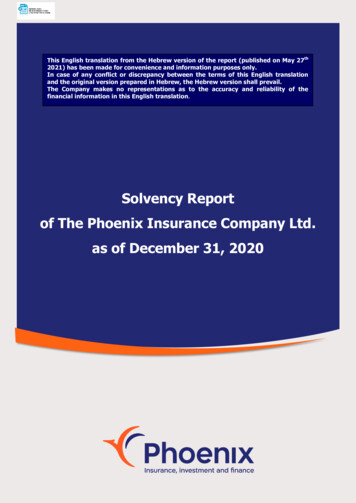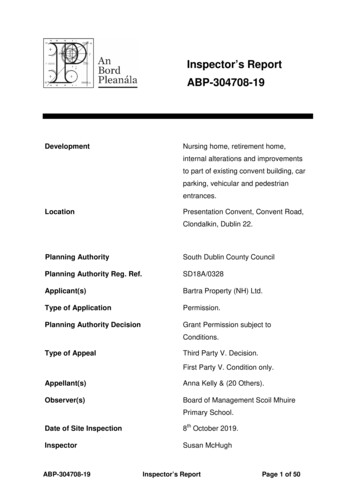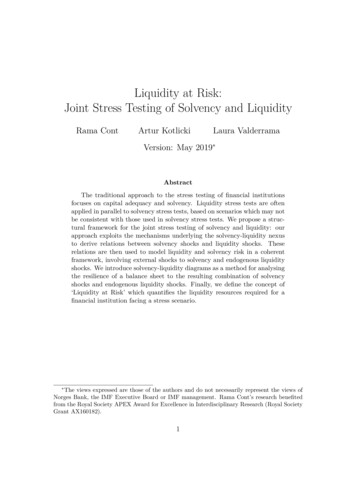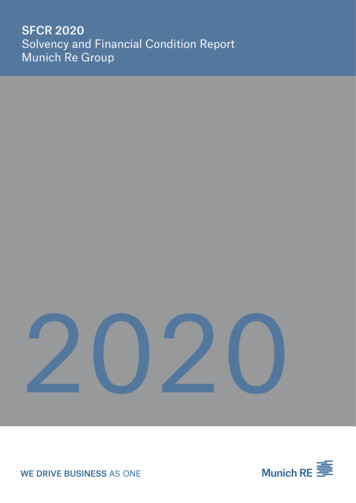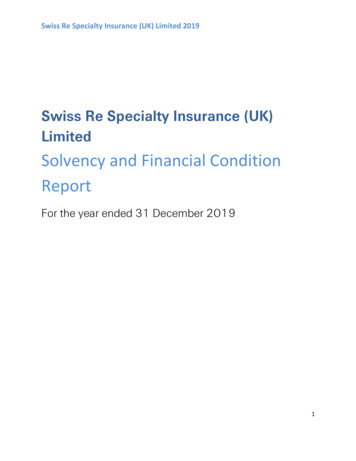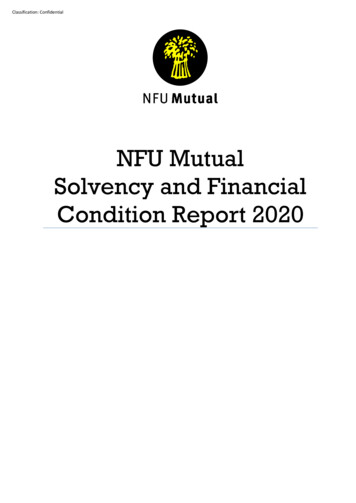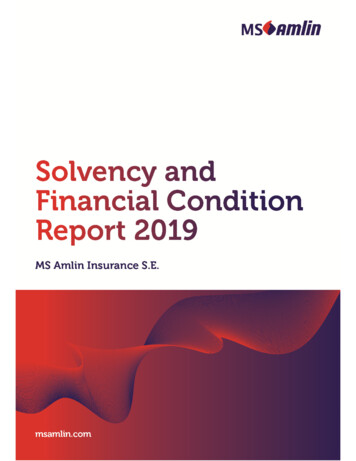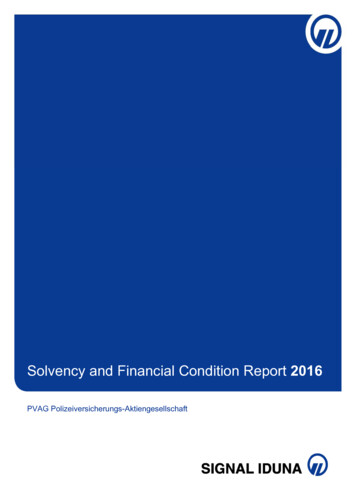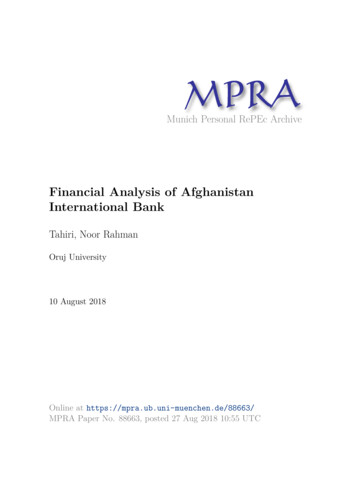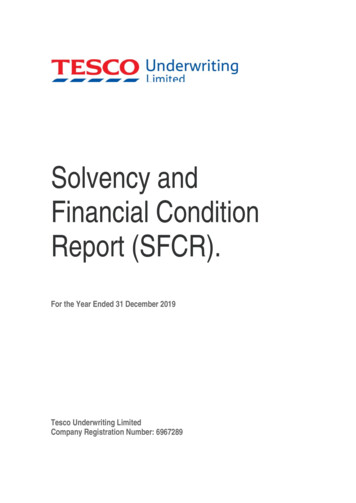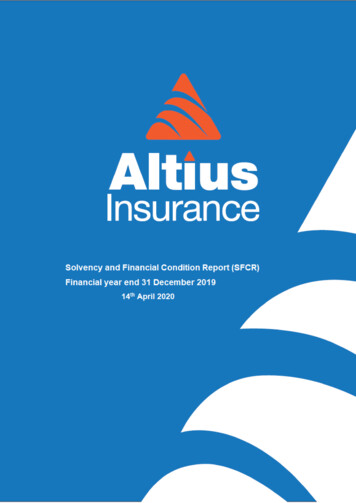
Transcription
Solvency and Financial Condition ReportPage 1 of 61
Solvency and Financial Condition ReportTABLE OF CONTENTSEXECUTIVE SUMMARY . 4A. BUSINESS AND PERFORMANCE . 6A.1 Business . 6A.2 Underwriting Performance . 7A.3 Investment Performance . 9A.4 Performance of other activities . 9A.5 Any Other Information . 9B. SYSTEM OF GOVERNANCE . 10B.1 General information on the system of governance . 10B.2 Fit and proper requirements . 11B.3 Risk management system including the own risk and solvency assessment . 12B.4 Internal control system . 15B.5 Internal audit function . 17B.6 Actuarial function . 17B.7 Outsourcing . 18B.8 Any other information . 18C. RISK PROFILE . 19C.1 Underwriting risk . 19C.2 Market risk . 20C.3 Credit risk . 21C.4 Liquidity risk. 21C.5 Operational risk. 21C.6 Other material risks . 21C.7 Any other information . 22D. VALUATION FOR SOLVENCY PURPOSES . 23D.1 Assets . 23D.2 Technical provisions . 25D.3 Other liabilities . 38D.4 Alternative methods for valuation. 38D.5 Any other information . 38E. CAPITAL MANAGEMENT . 39E.1 Own Funds. 39E.2 Solvency Capital Requirement and Minimum Capital Requirement. 41E.3 Use of duration based equity risk sub module in the calculation of SCR . 43E.4 Differences between standard formula and any internal model used. 43Page 2 of 61
Solvency and Financial Condition ReportE.5 Non compliance with SCR and MCR . 43E.6 Any other information . 43F. APPENDICES . 44F.1 Organisational structure . 44F.2 Public QRT’s . 45F.3 Audit Report/Opinion . 58Page 3 of 61
Solvency and Financial Condition ReportEXECUTIVE SUMMARYOverviewThis Report is based upon the financial position of Altius Insurance Ltd (thereinafter Company),with reference to the requirements of Law on Insurance Brokerage and Other Related Issues Lawof 2019 (38(I)2019), Delegated Acts and the guidelines issued by EIOPA as these were revisedon 8 March 2019. This is the fourth Solvency Financial Condition Report (SFCR) for AltiusInsurance Ltd based on the financial position as at 31 December 2019 that is required to bepublished by the Company.This Report contains qualitative and quantitative information in accordance with the order of theSuperintendent of insurance in relation to submission of information dated February 2017 / Article304 (1) of the Delegated regulation (EU)2015/35 provide further SFCR related rules, in particularon its structure.The SFCR, includes a summary of any material changes that occurred in the Company’sbusiness, risk profile, solvency position and system of governance since the last reporting period.The ultimate Administrative Body that has the responsibility for all of these matters is theCompany’s Board of Directors (the ‘Board’), with the help of various governance and controlfunctions that has put in place to monitor and manage the business.This Report was approved by the Company’s Board of Directors on 14 April 2020 and is inaccordance with the Disclosure and reporting policy.The information in this Report has been subject to external audit according to the orders of theSuperintendent of Insurance. The Auditor’s Report is presented in Appendix F3. However, theinformation is subject to supervisory assessment.Business and performanceThe Company has complied at all times with all aspects of the Solvency II regulations from thedate of its first implementation on 1 January 2016.Altius Insurance Limited, ex-Alpha Insurance Ltd, was founded in Cyprus on May 6, 1993. OnJanuary 16, 2015, Alpha Insurance came entirely under the control of a group of investors led byMr. Doukas Paleologos, with the participation of a significant number of the Firm’s Managers andwas renamed to Altius Insurance Ltd. The Company is active in the insurance sector, providingthe full range of the related services: life insurance, non-life (general) insurance and healthinsurance.The Company is represented in all the cities of Cyprus, and a rather extended network, operatingthrough several agents and insurance consultants. Also, the Company’s products are alsoavailable through Alpha Bank’s branch network in Cyprus, in accord with the Bancassuranceagreement made with Alpha Bank.System of GovernanceThe members of the BoD serve as the elected representatives of the current and futureshareholders, act as advisers and counselors to the General Manager / CEO and SeniorManagement and oversee the Senior Management’s performance on behalf of the shareholders.In performing its overall oversight function, the BoD reviews and assesses the Company’sstrategic and business planning, its solvency, as well as the Senior Management’s approach toaddressing significant risks and challenges facing the business. As part of this function, the BoDreviews and discusses reports regularly submitted to the BoD by Senior Management with respectto financial and non-financial performance. In performing its oversight function, the BoD maintainsfrequent, active and open communication and discussions with the General Manager / CEO andthe Executive Committee.Page 4 of 61
Solvency and Financial Condition ReportThe members of the Board of Directors remained fit and proper according to the Solvency IIrequirements.In order to strengthen its internal control system, the Company has maintained the followinginternal control functions, in accordance with Solvency II requirements. Risk management FunctionActuarial FunctionInternal Audit FunctionCompliance FunctionRisk ProfileA key component of the risk management system and the Own Risk and Solvency Assessment(ORSA) is the annual risk assessment exercise through which the Company assesses its positionregarding the different risks to which it is or might be exposed, with the use of Risk Register. Theassessment covers all risk types, including less quantifiable risks and aims to determine theCompany’s risk profile taking into consideration its risk appetite.Valuation of Assets and LiabilitiesThe Company prepares its financial Statement in accordance with International FinancialReporting Standards (IFRS).Capital ManagementThe Solvency coverage ratio at 31 December 2019 was 199% (31/12/2018: 207%) with own fundsof 21.712.000 (31/12/2018: 20.235.000), a Solvency Capital Requirement (SCR) of 10.923.000 (31/12/2018: 9.793.000) and a Minimum Capital Requirement (MCR) of 7.400.000(31/12/2018: 7.400.000).Page 5 of 61
Solvency and Financial Condition ReportA. BUSINESS AND PERFORMANCEA.1 BusinessCompany InformationAltius Insurance Ltd is one of the four active composite companies in Cyprus writing both life andnon-life business.Altius Insurance Ltd focuses in the following material lines of business: Life Health Fire and other Damage to Property General Liability Personal Accident Motor Marine, Cargo and Goods in TransitThe Company focuses on business written in Cyprus. The Company remains focused on theindividual and bancassurance business where the margins are better, however it regards thegroup business as an important part of its operations as it helps in the image of the company andit opens up new clientele for individual business as well. In terms of distributions channels, theCompany remains focused on the tied agency and bancassurance channels while maintainingand servicing a direct portfolio.Country branchesThe Company has its head office in Nicosia and branches in all cities (6 branches in Nicosia, 2 inLimassol, 1 in Paphos and 1 in Larnaca). The number of full-time equivalent employees are 93(as at 31/3/2020).The Company’s registered office, its principal location and its external auditors contact details areshown below respectively.Registered OfficeAltius Insurance LtdCorner Kennedy Avenue & Stasinou StrP.O.BOX 265161640 NicosiaCyprusExternal AuditorsKPMG LimitedEsperidon Street 14P.O Box 21121CyprusPage 6 of 61
Solvency and Financial Condition ReportA.2 Underwriting PerformanceThe risk appetite statement has been formalized and approved by the Board of Directors. Thereinsurance programme for all types of business is such that the retained risks are all capped tothe extent that any large losses have limited impact on the overall profitability of the company. Inparticular, for the main types of risks the limits on retained sums insured per risk placed throughreinsurance are described under the opinion on the reinsurance programme.The underwriting policies have been finalized and approved. There are detailed underwritingguidelines for all types of business which are a combination of internally developed rules as wellas manuals developed by the reinsurers, reinsuring each type of business.The pricing of the products is such that the standard premium takes into account the general riskprofile of the portfolio based on past experience e.g. gender, age and occupation. However,additional high risks are also priced on an individual basis or additional terms are imposed beforethe risk is accepted e.g. for health reasons in life and health business, for adverse experience ofpast claims in motor business or high-risk vehicles, for certain materials in property business andso on.Pricing is consistent with the current guidelines and is sufficient to generate returns for thebusiness overall.Non-life BusinessThe gross claims and combined ratios of the non-life business for year 2019 and the comparativesof the previous year is summarized below:Class ofbusinessMedical ExpensesIncome ProtectionMotor VehicleLiabilityOther MotorInsuranceLoss Ratio20192018Claims Ratio66%65%Combined Ratio87%86%Claims Ratio19%27%Combined Ratio42%49%Claims Ratio77%79%Combined Ratio113%114%Claims Ratio97%85%Combined Ratio132%118%Claims Ratio6%32%Combined Ratio35%63%Claims Ratio13%38%Combined Ratio42%67%Claims Ratio26%25%Combined Ratio53%50%FireMarineLiabilityPage 7 of 61
Solvency and Financial Condition ReportThe impact of reinsurance on underwriting performances described below via the net claims andcombined ratios:Class of businessMedical ExpensesIncome ProtectionMotor VehicleLiabilityOther MotorInsuranceFireMarineLiabilityNet Loss Ratio20192018Net Claims Ratio70%68%Net Combined Ratio88%86%Net Claims Ratio34%44%Net Combined Ratio70%81%Net Claims Ratio62%73%Net Combined Ratio100%111%Net Claims Ratio101%90%Net Combined Ratio142%126%Net Claims Ratio12%19%Net Combined Ratio56%60%Net Claims Ratio17%30%Net Combined Ratio50%63%Net Claims Ratio15%34%Net Combined Ratio61%76%The underwriting profit of the non-life and medical expense business based on the company’sIFRS accounts for year 2019 and the comparative of the previous year is summarized below andis net of reinsurance:20192018 Net underwriting profit before tax3.989.7603.076.776Life BusinessThe underwriting profit of the life business based on the company’s IFRS accounts for year 2019and the comparative of the previous year is summarized below and is net of reinsurance:Net underwriting profit before tax2019 2018 1.803.383915.254Overall profitabilityThe profit and other comprehensive income after tax for the Company as a whole was as follows.Profit and other comprehensive income after taxPage 8 of 612019 2018 5.006.3572.515.800
Solvency and Financial Condition ReportA.3 Investment PerformanceDuring the year, the total investment return of the assets amounted to 5.879.625 (2018: 291.237).Unit-funds linked to life insurance policiesDuring the year, the total investment return held by policy holders under unit-linked policiesamounted to 3.104.011 (2018: 803.585) and is analyzed as follows.The Investment performance of the unit funds as at 31st of December 2019 (Linked to lifeinsurance products) are as follows.Performance AnalysisAnnualreturn (%) 201913.2Annualreturn (%) 2018-2.8Altius Global Fixed Income5.10.0Altius Global Equity21.4-7.7Altius Cash1.02.1Altius Global Balanced11.9-5.2FundAltius OptimaNon-linked assetsDuring the year, the total investment return under non-linked assets amounted to 2.775.614(2018: 512.348 loss).Altius Insurance’s total assets, which are not linked to investment funds and were available forinvestment, were 40.3 million at 31 December 2019.ooOut of this total, an amount of 32.8 million was invested in bonds, real estate and equities.The return of the mentioned bond and real estate portfolio was 7.4% for the whole year 2019,and 0.4% in respect of the fourth quarter.A.4 Performance of other activitiesThere was no material income from other activities.A.5 Any Other InformationThere was no any other information.Page 9 of 61
Solvency and Financial Condition ReportB. SYSTEM OF GOVERNANCEB.1 General information on the system of governanceThe organizational structure and reporting lines of the Company are designed to: Enable apportionment of responsibilities and clear accountabilities and responsibilities. Facilitate prompt transfer of information to all persons who need it. Prevent conflicts of interest, in cases where multiple tasks are performed by the sameindividual or organizational unit. Ensure the prudent and effective management of the Company.The three lines of defence are embedded within the organizational structure and reporting lines,in order to enforce an effective internal control system. The Company’s ultimate supervisory bodyis the BoD.The Senior Management, through the General Manager / CEO has the day to day responsibilityfor the implementation of the BoD’s approved strategy and reports to the BoD. Reporting to theBoD is both structured, through planned meetings and regular reporting and ad hoc as required.The Business Functions of the Company through their Head / Senior Managers have theresponsibility for the implementation of the BoD’s strategy in their business functions. They reportdirectly to the General Manager / CEO with regards to their day-to-day duties. In order to minimizethe probability of a potential conflict of interest and preserve their operational independence, thekey control functions have additional direct reporting lines to the BoD or Board Committees.The internal organisational structure, including a detailed organisational structure chart andpositions of key function holders is given in Appendix F1.The Company’s s remuneration policies and practices closely link pay to business strategy, riskprofile and long term performance against objectives. Remuneration practices are structured insuch a way that avoids potential incentive for unauthorized or unwanted risk taking.The Company, in assessing the performance of its Senior Management, BoD and key functionholders considers the following financial and non-financial variables: ooooooFinancial performance of the organization in relation to market conditions, competition andthe Company’s own strategy.Non-financial targets related to the contribution to the performance of the Company orfunction.Non-financial factors relating to skills, personal development, compliance with the Company’sinternal rules and procedures, compliance with the code of ethics and standards ofprofessional conduct under the Fit and Proper requirements.The remuneration of all employees is based on an assessment of the individual’sperformance against objectives. The following aspects are also considered:The overall strategy of the Company.The broader performance Management Framework of the Company.The compliance culture that is implemented in the Company.The Company’s Code of Ethics.The impact of the remuneration policy and practices on policy holders beneficiaries.The measures implemented in order to avoid conflicts of interest between the employees andthe Company as a whole.The Company believes that personnel responsible for/engaged in activities that involve significantrisk-taking should be rewarded adequately in order to attract and retain skilled individuals.Notwithstanding this fact, the remuneration should be aligned with the achievement of theobjectives of their responsibilities and not just in relation to the performance of the business areasthey belong to. Similarly, the individual business areas have to take account of the Company’soverall performance.Page 10 of 61
Solvency and Financial Condition ReportThe measurement of individual performances is central to a sound remuneration policy. Definingthe pay-out should not be a purely mechanical process based on measurable performance criteriabut should include the ability to exercise judgment.The Governing Body bears the ultimate responsibility for ensuring that Corporate Governancearrangements within the Company are sufficient and appropriate to the size, nature andcomplexity of its business. The BoD may delegate authority to certain Committees in order tomonitor and oversee specific aspects of the business. Delegating to specialized Committees doesnot in any way release the BoD from collectively discharging its duties and responsibilities.Specifically, the BoD has regular and robust interaction with the Committees, requestinginformation from them proactively and challenging them when necessary.Audit CommitteeThe Committee shall be accountable to the BoD and shall assist the BoD in meeting itsresponsibilities in ensuring an effective system of internal control and compliance and for meetingits external financial reporting obligations, under applicable laws and regulations and shall bedirectly responsible on behalf of the BoD for the selection, oversight and remuneration of theexternal auditor.Risk and Reserving CommitteeThe Committee as an advisory Committee to the BoD assists with the formulation of theCompany’s overall risk strategies and polices for managing significant business risks, and isresponsible for designing and implementing the Company Risk Management Framework. Inaddition, the Committee ensures that the Company’s overall system of internal control operateseffectively, and monitors and reviews risk exposures and breaches and monitors and approvesReserves.Remuneration and Nominations CommitteeThe Committee as an advisory Committee to the BoD, assists with the formulation of theCompany’s overall remuneration and nominations policies for defining remuneration practices aswell as senior appointment and promotions within the Company. In addition, the Committeeensures that these policies promote an effective system of internal control and makesrecommendations to the BoD for improvementsInvestment CommitteeThe Committee as an advisory Committee to the BoD assists with the formulation of theCompany’s overall investment strategy and policy, oversees and reports on the implementationof the investment strategy, and recommends any material changes to such strategy to the BoD.B.2 Fit and proper requirementsFitnessIn assessing the fitness of a person his/her professional competence and capability areconsidered.The assessment of professional competence covers the assessment of the competence in termsof Senior Management and in the area of business activities carried out by the Company(technical competence).This assessment is based on the person’s previous experience, knowledge, and professionalqualifications and should demonstrate due skill, care, diligence and compliance with the relevantstandards for the area sector they have worked in.The HR function is responsible for ensuring that all individuals receive appropriate training formaintaining their competence.Page 11 of 61
Solvency and Financial Condition ReportProfessional qualifications applicable to each key function are in line with the supervisoryauthority’s requirements.ProprietyIn assessing the propriety of a person, the Company assesses its honesty, integrity, reputationand financial soundness.The Company may take into account convictions for criminal offences, adverse findings in civilproceedings, or disciplinary actions by regulators in Cyprus or abroad.The criteria include an assessment of reasons to believe from past conduct that the person maynot discharge their duties in line with applicable rules, regulations and guidelines. Such reasonsmay arise from criminal antecedents, financial antecedents, and supervisory experience with thatperson or past business conduct. This approach does not imply that all previous infringementswill automatically result in a failure to meet the requirements, but rather than they will be assessedon a case by case basis by the Company before an appointment and application to thesupervisory authority is made.At application, criminal records checks will be performed for approved persons, and other selectedroles. Annual criminal records check of approved persons will not be conducted. Approvedpersons will self-certify that they remain proper.The Company will also consider whether the person has a debt that remains outstanding or wasnot paid within a reasonable period and/or has been involved in bankruptcy proceedings or otherinsolvency arrangements.B.3 Risk management system including the own risk and solvency assessmentThe Risk Management Function (RMF) is responsible for coordinating all risk managementactivities. Assisting Senior Management and the BoD in the effective operation of the Risk ManagementSystem, in particular by discussing the results of specialist analysis and quality reviews carriedout by the RMF and proposing possible solutions for addressing material system failures thatmay have been identified. Maintaining a Company-wide and aggregated view on the risk profile of the Company. Reporting details on risk exposures and advising the BoD, through the Risk and ReservingCommittee, on risk management matters in relation to strategic affairs such as corporatestrategy, mergers and acquisitions and major projects and investments. Assisting the BoD and Senior Management with capital and resource allocation decisions andfacilitating risk assessments, and Ensuring that there are sufficient and appropriate tools and methods in place for predicting,identifying, assessing, monitoring, controlling and reporting the Company’s risks. Coordinates all risk management activities across the Company and ensures the correctimplementation of risk policies. Monitoring, on a day-to-day basis, the Risk Management System, Identifying, assessing andmonitoring existing and emerging risks. Regularly evaluating the design and operational effectiveness of the Risk Management Systemto identify, measure, monitor, manage and report the risks to which the Company is exposed. Monitoring compliance by the Company’s Senior Management and staff with all established riskpolicies and procedures. The RMF cooperates with other functions and business areas to carry out its role and in thiscontext, it operates within the structure of the Company and under the oversight of the SeniorManagement.Page 12 of 61
Solvency and Financial Condition ReportThe ORSA is a component of the overall control system of the Company. This allows themanagement to take into account all the risks associated with the Company’s businessstrategies and the required level of capital that the Company needs to cover such risks.Therefore, strategic decisions such as the expansion into new markets, the introduction of newproducts, etc. are assessed and evaluated in the light of their effect on the Company’s risksituation and risk-bearing capacity.The Company follows the steps below to implement its ORSA:1.Define the driving factors before ORSA planning2.Identify and classify risks, including governance3.Assessment and measurement of material risks through different approaches includingstress testing4.Capital Allocation5.Prepare capital planning for the next 3-5 years6.Stress test and decide on actions in case the risks are crystallized7.Communicate and document the results8.Confirm that the ORSA process is embedded in the decision making of the CompanyPage 13 of 61
Solvency and Financial Condition ReportThe Diagram below illustrates the ORSA process and how this is linked to the business strategy ofthe mentActions/ContingencyRiskAssessmentStress TestingORSACapitalPlanningCapitalAllocationPage 14 of 61
Solvency and Financial Condition ReportB.4 Internal control systemInternal control is a process affected by the Company’s BoD, Senior Management, and otherpersonnel and is designed to provide reasonable assurance regarding the achievement ofobjectives in the following categories: Effectiveness and efficiency of operations. Reliability of financial reporting and non-financial information. Compliance with applicable laws and regulations. Achievement of Company’s strategy and objectives.Internal Control is an important aspect of corporate governance since a system of effectiveinternal controls is fundamental to the safe and sound management of the Company. Effectiveinternal controls help the Company protect and enhance shareholders’ value and reduce thepossibility of unexpected losses or damage to its reputation. Effective internal control alsoreduces the possibility of significant errors and irregularities and assists in their timely detectionwhen they do occur.The relationship between internal control and corporate governance is shown in the diagrambelow.Internal Control and Corporate GovernanceCommunication ofObjectives, Policies nvironment,Integrity &Ethical ValuesBoard Codeof EthicsManagement’s Philosophy,Expectations & MethodsOther EntityLevel ControlsProcess LevelControlsFinancial Reporting &DisclosureIn accordance with the standardized framework for internal control used by COSO, there are fiveinterrelated components of effective internal control, which are discussed in the following sections: Control Environment.Risk Assessment.Control Activities.Reporting.Monitoring.Page 15 of 61
Solvency and Financial Condition ReportThese are described in the figure below:Five Components of Internal ControlThe Company has established the necessary tools for assessing its internal control system.Compliance FunctionThe Compliance Function is responsible for ensuring that all actions undertaken by the Companyare, at all times, in compliance with all applicable laws and regulations. In line with best practice,it is also responsible to take measures to monitor the compliance of the Company with internalstrategies, policies, processes a
Altius Insurance Limited, ex-Alpha Insurance Ltd, was founded in Cyprus on May 6, 1993. On January 16, 2015, Alpha Insurance came entirely under the control of a group of investors led by Mr. Doukas Paleologos, with the participation of a significant number of the Firm's Managers and was renamed to Altius Insurance Ltd.
